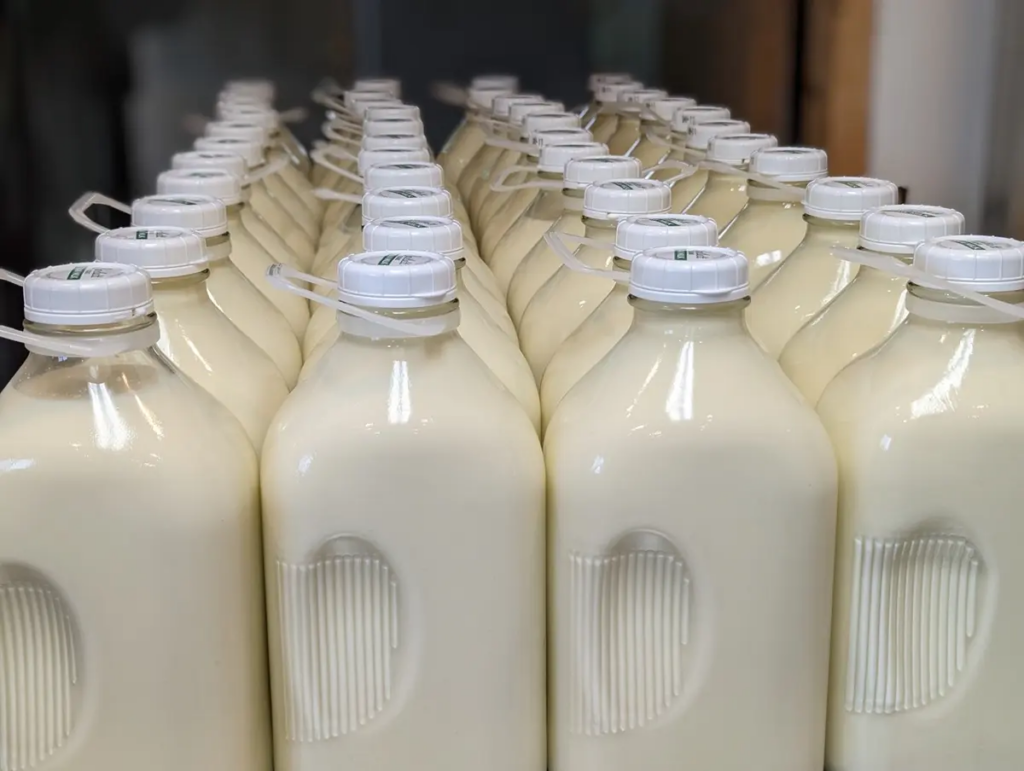We’ve been getting raw milk from a local ranch here in Wyoming, and it’s outstanding. It still has some cream in it, and the flavor and nutrition is on another level not to mention making some of the best ice cream. Our rancher uses plastic bags which has a great benefit in that you can squeeze the air out and it starves the bacteria that would otherwise consume the sugar in the milk, and what causes it to sour (even pasteurized milk has this problem and can pick up bacteria from the air as well as what is left after pasteurizing). By squeezing out the air you can get it to last about as long as pasteurized milk. And even after souring you can make sour cream or use it in baking recipes. A lot of what they do to food is to remove the nutrition, because they want you unhealthy and in their medical and pharmaceutical wealth transfer scheme.
By Matthew Lysiak

The raw milk movement, once the domain of fringe health outliers and conspiracy theorists, has gone mainstream as increasing numbers of states have formally legalized its consumption and sale.
On Aug. 1, North Dakota became the latest state to remove a prohibition of the sale of raw milk directly to consumers. North Dakotan farmer Peter Bartlett, whose family owns Bartlett Farms, which sells raw dairy products, told The Epoch Times that he has seen a boom in sales since restrictions were lifted.
“Right after the law was passed, we saw a significant increase in interest,” said Mr. Bartlett. “The legalization took it out of the realm of the black market—where you almost had to meet a dealer in a back alley if you wanted raw milk—and brought it out into the light.”
“It’s been a big shift. We have watched our business grow 40 percent a year,” added Mr. Bartlett.

Iowa enacted a similar law in July, joining 27 other states that have legalized the sale of unpasteurized milk. Regulations vary from state to state, with the product readily available at retail stores in Arizona, California, Connecticut, Idaho, Maine, Nevada, New Hampshire, New Mexico, Oregon, Pennsylvania, South Carolina, Utah, and Washington.
At least some of the newfound interest in raw milk can be attributed to an increased skepticism of health authorities and a corresponding societal movement that is seeing more people return to a more nature way of living, according to Mr. Bartlett, who has been in the raw milk business for more than 15 years.
“It is as if with social media we’ve seen this group reach a critical mass, whereas in the past my customers would be people who grew up on farms and wanted to drink the raw milk they drank as kids. But now we are seeing these millennial moms who are finding influencers that are recommending raw milk as part of a healthy, more holistic lifestyle.”
People who struggle with dairy allergies, and have come to a realization that it isn’t dairy but the pasteurization process that is causing the reaction, have also formed a strong segment of his customer base, according to Mr. Bartlett.
“We see a lot of people diagnosed with lactose intolerance who thrive on raw milk,” said Mr. Bartlett. “The results they have been sharing are really unbelievable.”
The raw milk movement has been years in the making. For decades, a community of dairy farmers and nutrition advocates have campaigned for the right of individuals to produce, sell, and consume fresh, unprocessed milk. Advocates claim the consumption of raw milk can lead to numerous health benefits, including improving the immune and digestive systems, as well as being a cure for eczema and irritable-bowel syndrome. The pasteurization not only destroys dangerous pathogens like E. coli, salmonella, and campylobacter but also destroys its healthy nutrients, according to raw milk enthusiasts.
However, government agencies insist the potential downside of drinking raw milk far outweighs any perceived benefits.
The Centers for Disease Control (CDC) and other agencies advise against it, claiming that raw milk “can carry harmful germs, such as campylobacter, cryptosporidium, E. coli, listeria, brucella, and salmonella” that “can pose serious health risks to you and your family.” The CDC claims that raw milk-related outbreaks led to 2,645 illnesses and 228 hospitalizations between 1998 and 2018.
The Food and Drug Administration (FDA) also warns against its consumption.
“Decades ago, pasteurization of milk was adopted as a basic public health measure to kill dangerous bacteria,” a statement read. “This measure largely eliminated the risk of getting sick from one of the most important staples of the American diet.”
Further, earlier this week Fresno-based producer Raw Farm LLC, which specializes in raw milk products, was forced to issue a recall after at least 19 salmonella cases were linked to their raw milk or milk products.
Michelle Dethloff, infectious diseases and epidemiology unit director for the North Dakota Department of Health and Human Services Public Health Division, warned lawmakers at a hearing in February before regulations were relaxed about the potential downfalls of ending the prohibition.
“Before routine pasteurization of milk began in the 1920s, many people became sick and some died of diseases,” said Mr. Dethloff. “Pasteurization continues to be an important public health intervention that offers consumers safe dairy choices.”
“Most of the nutritional benefits of drinking raw milk are available from pasteurized milk without the risk of disease-causing illness or serious long-term consequences,” Mrs. Dethloff added.
Mr. Bartlett, who owns 15 cows and delivers his raw milk to the major population centers in North Dakota in glass bottles, said that following the COVID-19 pandemic, when sometimes wrong or contradictory advice often came out from public health officials, that the erosion of public trust that led some to reevaluate their views on his product.
“It seemed like after what happened with COVID, there were a lot less people who cared about what the CDC or FDA said anymore,” said Mr. Bartlett. “People are becoming more skeptical of their authorities and beginning to ask themselves, wait a minute, haven’t people been drinking raw milk for thousands of years and thrived?”
However, while health risks associated with raw milk may be overblown, consumers should have legitimate concerns over their supplier, according to Mr. Bartlett.
“It is important that if you do purchase raw milk, you make sure it is coming from a clean source,” said Mr. Bartlett. “But fresh, clean raw milk is absolutely amazing. Have a glass, with all those healthy nutrients inside of it, your body will thank you.”